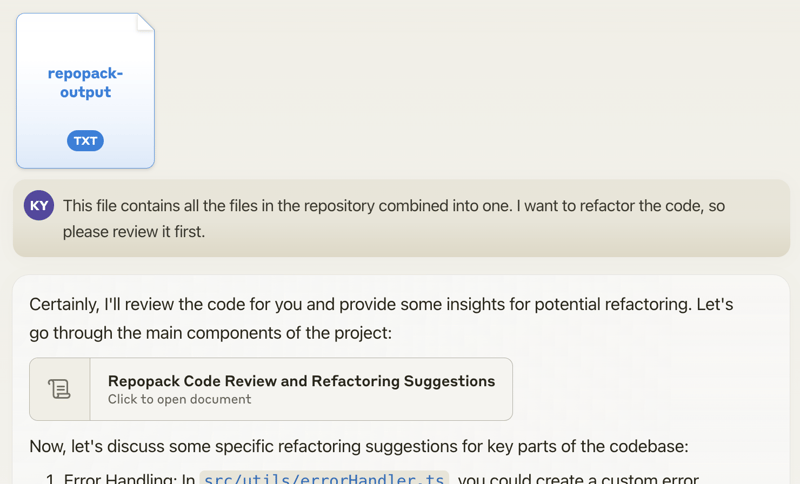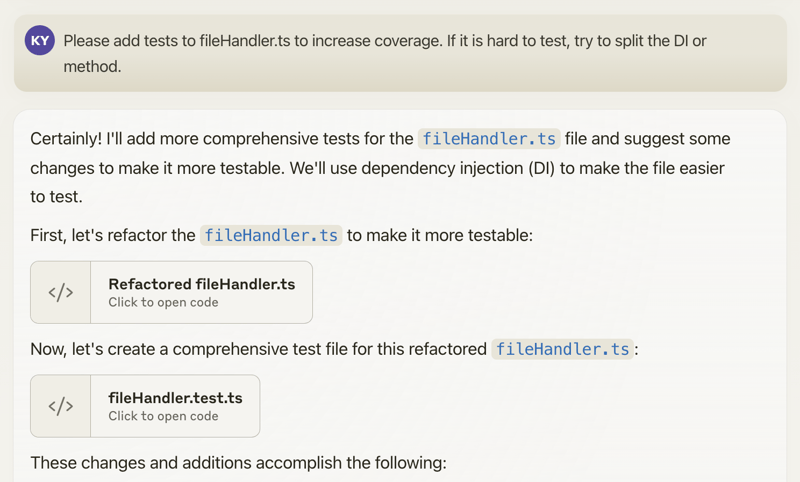🏆 Open Source Awards Nomination
We're honored! Repomix has been nominated for the Powered by AI category at the JSNation Open Source Awards 2025.
This wouldn't have been possible without all of you using and supporting Repomix. Thank you!
If Repomix has helped you analyze or pack codebases for AI tools, we'd be grateful for your vote in the Powered by AI category.
What is Repomix?
Repomix is a powerful tool that packages your entire codebase into a single AI-friendly file. Whether you're working on code reviews, refactoring, or getting AI assistance with your project, Repomix makes it easy to share your entire repository context with AI tools.
Quick Start
Once you've generated a packed file (repomix-output.xml) using Repomix, you can send it to an AI assistant (like ChatGPT, Claude) with a prompt like:
The AI will analyze your entire codebase and provide comprehensive insights:

When discussing specific changes, the AI can help generate code. With features like Claude's Artifacts, you can even receive multiple interdependent files:

Happy coding! 🚀
Repomix can be used as a command-line tool, offering powerful features and customization options.
The CLI tool can access private repositories as it uses your locally installed git.
Quick Start
You can try Repomix instantly in your project directory without installation:
Or install globally for repeated use:
bash
# Install using npm npm install -g repomix # Alternatively using yarn yarn global add repomix # Alternatively using bun bun add -g repomix # Alternatively using Homebrew (macOS/Linux) brew install repomix # Then run in any project directory repomixThat's it! Repomix will generate a repomix-output.xml file in your current directory, containing your entire repository in an AI-friendly format.
Usage
To pack your entire repository:
To pack a specific directory:
bash
repomix path/to/directoryTo pack specific files or directories using glob patterns:
bash
repomix --include "src/**/*.ts,**/*.md"To exclude specific files or directories:
bash
repomix --ignore "**/*.log,tmp/"To pack a remote repository:
bash
# Using shorthand format npx repomix --remote yamadashy/repomix # Using full URL (supports branches and specific paths) npx repomix --remote https://github.com/yamadashy/repomix npx repomix --remote https://github.com/yamadashy/repomix/tree/main # Using commit's URL npx repomix --remote https://github.com/yamadashy/repomix/commit/836abcd7335137228ad77feb28655d85712680f1To initialize a new configuration file (repomix.config.json):
Once you have generated the packed file, you can use it with Generative AI tools like Claude, ChatGPT, and Gemini.
Docker Usage
You can also run Repomix using Docker 🐳
This is useful if you want to run Repomix in an isolated environment or prefer using containers.
Basic usage (current directory):
bash
docker run -v .:/app -it --rm ghcr.io/yamadashy/repomixTo pack a specific directory:
bash
docker run -v .:/app -it --rm ghcr.io/yamadashy/repomix path/to/directoryProcess a remote repository and output to a output directory:
bash
docker run -v ./output:/app -it --rm ghcr.io/yamadashy/repomix --remote https://github.com/yamadashy/repomixOutput Formats
Choose your preferred output format:
bash
# XML format (default) repomix --style xml # Markdown format repomix --style markdown # Plain text format repomix --style plainCustomization
Create a repomix.config.json for persistent settings:
json
{ "output": { "style": "markdown", "filePath": "custom-output.md", "removeComments": true, "showLineNumbers": true, "topFilesLength": 10 }, "ignore": { "customPatterns": ["*.test.ts", "docs/**"] } }Power Users Guide
Repomix offers powerful features for advanced use cases. Here are some essential guides for power users:
- MCP Server - Model Context Protocol integration for AI assistants
- GitHub Actions - Automate codebase packing in CI/CD workflows
- Code Compression - Tree-sitter based intelligent compression (~70% token reduction)
- Using as Library - Integrate Repomix into your Node.js applications
- Custom Instructions - Add custom prompts and instructions to outputs
- Security Features - Built-in Secretlint integration and safety checks
- Best Practices - Optimize your AI workflows with proven strategies
More Examples
Need more help? 💡
Check out our comprehensive documentation in the Guide or explore the GitHub Repository for more examples and source code.
.png)




